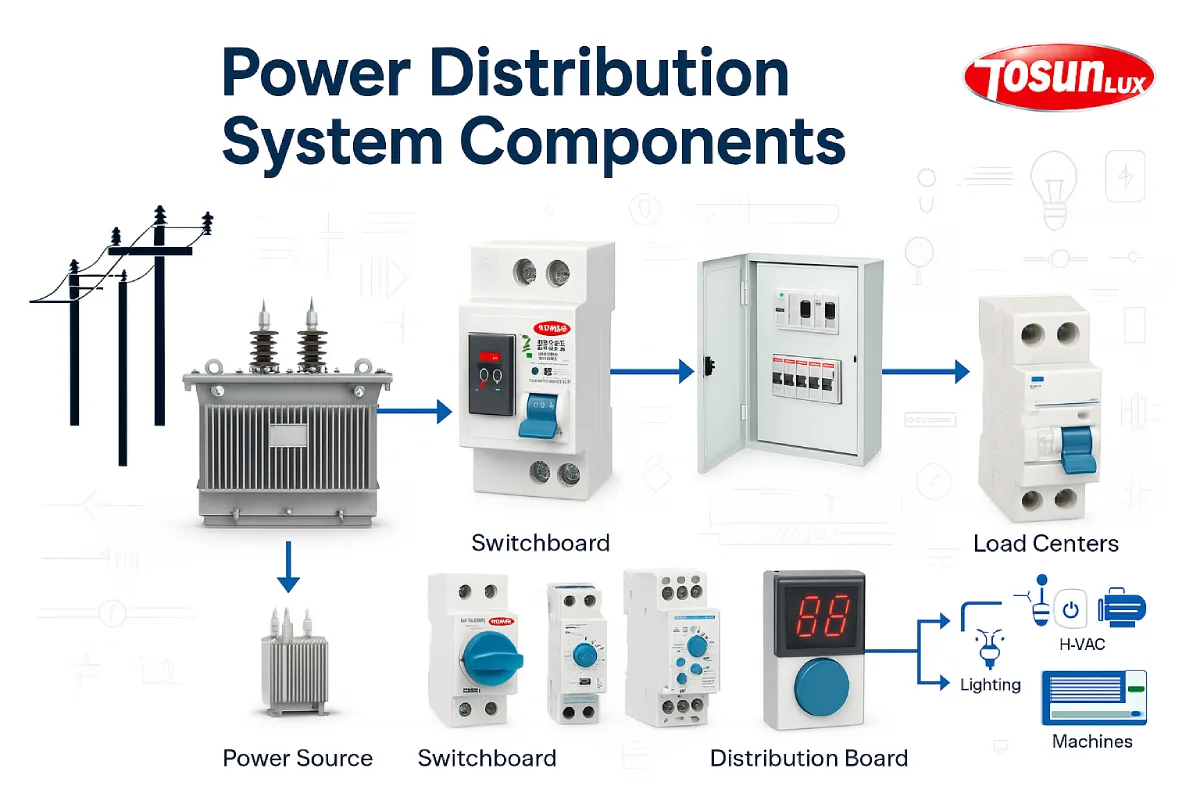Ռելեի կյանքի տևողություն. Ինչպես են ամենօրյա շահագործումն ու սպասարկումը ազդում երկարակեցության վրա
Բովանդակություն
ՓոխարկելՌելեի ծառայության ժամկետը ուղղակիորեն կախված է նրանից, թե ինչպես է այն շահագործվում և պահպանվում։
Դժվար պայմաններում կանոնավոր օգտագործումը կարող է կրճատել դրա կյանքը, մինչդեռ ճիշտ տեղադրումը և ժամանակին սպասարկումը կարող են զգալիորեն երկարացնել այն։
Անկախ նրանից, թե գործ ունեք բարդ արդյունաբերական մեքենաների, թե պարզ հզորության անջատման հետ, ռելեների գործառույթը և դրանց խնամքը հասկանալը շատ կարևոր է։
Այս հոդվածում մենք կանդրադառնանք ռելեի կյանքի տևողությանը ազդող գործոններին, թե ինչպես են տարբեր ռելեային կիրառությունները ազդում աշխատանքի վրա և ինչ կարող եք անել ձեր ներդրումից առավելագույնս օգտվելու համար։
Ռելեի բացատրությունը. Ի՞նչ է ռելեը և ինչո՞ւ է այն կարևոր։
Նախքան կատարողականի և երկարակեցության մասին խորանալը, կարևոր է հասկանալ հիմունքները։
Պարզ ասած, ռելեն էլեկտրականորեն աշխատող անջատիչ է, որն օգտագործվում է շղթան կառավարելու համար՝ էլեկտրական ազդանշանին ի պատասխան կոնտակտները բացելով կամ փակելով։
Այն թույլ է տալիս կառավարել ցածր հզորության սարքերը բարձր հզորության սարքերի վրա, դարձնելով այն ժամանակակից էլեկտրական համակարգերի անփոխարինելի բաղադրիչ։
Ռելեները լինում են տարբեր տեսակի՝ կախված կիրառությունից՝ էլեկտրամեխանիկական, պինդ վիճակի, ժամանակային հապաղմամբ և այլն:
Յուրաքանչյուր տեսակ ծառայում է տարբեր նպատակի, այդ իսկ պատճառով ճիշտը ընտրելը և դրա գործունեության սկզբունքը հասկանալը կարևոր է համակարգի ընդհանուր արդյունավետության և անվտանգության համար։

Ի՞նչն է ազդում ռելեի կյանքի տևողության վրա:
Միջինում ռելեն պատահականորեն չի խափանվում. այն մաշվում է շատ կոնկրետ գործոնների պատճառով։ Ահա, թե ինչն է սովորաբար ազդում ռելեի աշխատանքի տևողության վրա.
1. Կոնտակտային բեռ
Որքան ավելի ծանր է ռելեի կոնտակտների վրա բեռը, այնքան ավելի շատ մաշվածություն է առաջանում: Անջատման ժամանակ առաջացող աղեղային աղեղները կարող են քայքայել կոնտակտային նյութը, հատկապես հաճախակի միացման և անջատման ցիկլերի դեպքում:
2. Փոխարկման հաճախականություն
Բարձր արագությամբ անջատումը կամ արագ ցիկլավորումը կրճատում է ռելեի կյանքի տևողությունը։ Յուրաքանչյուր գործողություն փոքր-ինչ մաշում է կոնտակտները, ուստի որքան հաճախ է այն օգտագործվում, այնքան շուտ այն փոխարինման կարիք կունենա։
3. Շրջակա միջավայրի ջերմաստիճան
Ավելորդ ջերմությունը կամ ցուրտը կարող են ազդել ռելեի ներքին բաղադրիչների վրա: Բարձր ջերմաստիճանների երկարատև ազդեցությունը, մասնավորապես, արագացնում է մեկուսացման քայքայումը և շփման կոռոզիան:
4. Մեխանիկական ցնցում և թրթռում
Արդյունաբերական պայմաններում կամ շարժական մեքենաներում (օրինակ՝ գյուղատնտեսական կամ շինհրապարակային սարքավորումներ) տատանումները կարող են մեխանիկական հոգնածություն առաջացնել ռելեի բաղադրիչներում։
5. Էլեկտրամատակարարման որակը
Լարման անկանոնությունները, ինչպիսիք են կտրուկ տատանումները կամ կտրուկ անկումները, կարող են կրճատել ռելեի կյանքի տևողությունը: Լարման տատանումները մեծացնում են ռելեի կծիկների և ներքին մեխանիզմների վրա լարվածությունը:
Ռելեային գործողություններ իրական աշխարհի միջավայրերում
Ռելեների տարբեր միջավայրերում կիրառման եղանակը զգալիորեն ազդում է աշխատանքի և դիմացկունության վրա: Եկեք ուսումնասիրենք ռելեների մի քանի տարածված կիրառություններ.
Արդյունաբերական սարքավորումներ
Արդյունաբերական օբյեկտներում ռելեները հաճախ օգտագործվում են շարժիչի կառավարման, գերծանրաբեռնվածությունից պաշտպանության և գործընթացների ավտոմատացման համար: Այս միջավայրերը սովորաբար կոշտ են, լի փոշով, թրթռումներով և բարձր բեռնվածությամբ: Նման պայմաններում ռելեները պետք է լինեն ամուր և հուսալի:
Սառնարանային և HVAC համակարգեր
HVAC համակարգերում ռելեները անընդհատ միացնում են կոմպրեսորները, օդափոխիչները և ջերմակարգավորիչները: Հուսալի ռելեն ապահովում է կայուն աշխատանք և կանխում համակարգի խափանումները:
AC միավորի կիրառման համար ճիշտ կոնտակտորի ընտրությունը կարող է նաև ազդել ինչպես արժեքի, այնպես էլ երկարակեցության վրա:
Եռաֆազ էներգիայի մոնիթորինգ
Ահա թե որտեղ են փայլում TOSUNLUX TRV8 եռաֆազ լարման ռելեի նման սարքերը։
TRV8-ը նախատեսված է փուլերի հաջորդականության, փուլային անսարքության, գերլարման և ցածր լարման պայմանների, ինչպես նաև լարման ասիմետրիայի վերահսկման համար, և ապահովում է համակարգի անվտանգությունը և անխափան աշխատանքը։
Դրա վերագործարկման ժամանակը 1000 մվ է և մաքուր LED ցուցիչներ նպաստում են ռելեի աշխատանքի և հուսալիության բարելավմանը։
Ռելեի կյանքի տևողությունը մեծացնելու լավագույն փորձը
Հիմա, երբ մենք գիտենք, թե ինչն է կրճատում ռելեի կյանքը, ահա քայլեր, որոնք կարող եք ձեռնարկել այն երկարացնելու համար.
1. Օգտագործեք կիրառման համար ճիշտ ռելե
Ոչ բոլոր ռելեները նախատեսված են նույն աշխատանքը կատարելու համար։
Օրինակ, ժամանակի հետաձգմամբ ռելեները հիանալի են բեռի հաջորդականության որոշման համար, մինչդեռ լարման մոնիթորինգի ռելեները, ինչպիսին է TRV8-ը, ավելի հարմար են զգայուն սարքավորումները պաշտպանելու համար։
Եթե աշխատում եք շարժիչների կամ HVAC համակարգերի հետ, ապա AC սարքի համար համապատասխան կոնտակտորի ընտրությունը, հատկապես ձեր բեռի համար նախատեսվածի, ինչպիսին է մոդուլային 25A կոնտակտորը, երկարաժամկետ աշխատանքի գրավականն է։
2. Կառավարման անջատման հաճախականությունը
Խուսափեք չափազանց կամ ավելորդ անջատումներից: Ծրագրավորեք կարգավորիչները կամ PLC-ները՝ հնարավորության դեպքում կրճատելու անջատման ցիկլերը:
3. Հետևեք և պահպանեք կապերը
Լուծված միացումները և քայքայված լարերը հանգեցնում են ջերմության կուտակման, որը կարող է քայքայել ռելեի կոնտակտները: Կանոնավոր ստուգումները կօգնեն ձեզ վաղ հայտնաբերել այս խնդիրները:
4. Պահպանեք ռելեն մաքուր
Փոշին և կեղտը կարող են առաջացնել կոնտակտային խափանում կամ մեկուսացնել բաղադրիչները՝ հանգեցնելով գերտաքացման: Ռելեի և դրա պատյանի մաքուր պահելը կանխում է ավելորդ մաշվածությունը:
5. Ապահովել լարման լարման պաշտպանություն
Տեղադրեք լարման կտրուկ տատանումներից վնասը կանխելու համար լարման գերլարումից պաշտպանող սարքեր, հատկապես անկայուն էլեկտրաէներգիայի հակված տարածքներում։
Ժամանակային ռելեներ և կատարողականի համապատասխանություն
Ժամանակ ռելե արտադրող ինչպես TOSUNLUX-ը գիտի, թե ինչպես նախագծել երկարակյաց ռելեներ։
Օրինակ՝ TRV8-ը առաջարկում է ուշացած արձագանքման տարբերակներ (0.1-ից մինչև 10 վայրկյան, կախված մոդելից), որոնք օգնում են կանխել լարման կարճատև տատանումների դեպքում ավելորդ անջատումները։
Սա ոչ միայն պաշտպանում է համակարգը, այլև երկարացնում է ռելեի կյանքի տևողությունը։
Դրա ներկառուցված պաշտպանությունը գերլարման, թերլարման և ասիմետրիայի դեմ այն դարձնում է հիանալի ընտրություն կարևորագույն համակարգերի համար, որտեղ նույնիսկ աննշան խափանումները կարող են լուրջ խնդիրներ առաջացնել։
Հուսալի գործընկեր ընտրելը կարևոր է
Ռելեի աշխատանքը կախված չէ միայն ապրանքի տեխնիկական բնութագրերից, այլ նաև... ռելե արտադրող.
TOSUNLUX-ը վստահելի անուն է ոլորտում, որն առաջարկում է լարման և ժամանակի ռելեների լայն տեսականի, որոնք հայտնի են որակով, հետևողականությամբ և նորարարությամբ։
Նրանց TRV8 մոդել հատկապես հարմար է արդյունաբերական, շարժական և գյուղատնտեսական կիրառությունների համար։
Իր առաջադեմ մոնիթորինգի հնարավորությունների և կարգավորվող կոճակների միջոցով օգտագործողին հարմար կարգավորման շնորհիվ, այն նախագծված է երկարակյաց լինելու և ճնշման տակ աշխատելու համար։
Նշաններ, որ ռելեի կյանքի ավարտը մոտենում է
Նույնիսկ ուշադիր սպասարկման դեպքում բոլոր ռելեները ի վերջո կմաշվեն: Ահա մի քանի տարածված նշաններ, որոնց պետք է ուշադրություն դարձնել.
- Անհամապատասխան անջատման կամ արձագանքի ուշացումներ
- Գերտաքացում կամ այրված հոտ
- Տեսանելի կոռոզիա կամ փոսիկներ կոնտակտների վրա
- Անսովոր բզզոց կամ կտտոց
- LED ցուցիչները չեն գործում սպասվածի պես
Խափանված ռելեն ժամանակին փոխարինելը կարող է կանխել համակարգային շատ ավելի մեծ խափանումներ՝ խնայելով ձեր ժամանակն ու գումարը։
Ռելեի արդյունավետություն. Փոքր սարք, մեծ ազդեցություն
Ռելեները կարող են թվալ փոքր բաղադրիչներ, բայց դրանց աշխատանքը ազդում է ամբողջ էլեկտրական համակարգի վրա։
Մաշված կամ վատ սպասարկվող ռելեն կարող է անջատումներ, սարքավորումների վնաս և նույնիսկ անվտանգության հետ կապված վտանգներ առաջացնել։
Ահա թե ինչու ռելեի աշխատանքը հասկանալը և ռելեի կյանքի տևողությանը հետևելը կարևոր է՝ ոչ միայն ինժեներների և տեխնիկների, այլև կայուն էներգահամակարգերի վրա հիմնված ցանկացած բիզնեսի համար։
Վերջնական մտքեր. Ռելեի կյանքի տևողություն
Երբ խոսքը վերաբերում է ռելեի կյանքի տևողության երկարացմանը, գիտելիքներին, կանխարգելմանը և սարքավորումների ճիշտ ընտրություն ձեր ամենաուժեղ դաշնակիցներն են։
Ամենօրյա գործողությունները, շրջակա միջավայրի պայմանները և ձեր բաղադրիչների որակը՝ այս ամենը դեր է խաղում։
Անկախ նրանից, թե դուք օգտագործում եք անջատման համար սովորական ռելե, թե խելացի լարման մոնիթորինգի սարք, ինչպիսին է TOSUNLUX TRV8-ը, մանրամասներին ուշադրությունը շատ կարևոր է։
Պահպանեք ձեր ռելեները լավագույն վիճակում, ընտրեք աշխատանքի համար ճիշտ մոդելը և աշխատեք հուսալի արտադրողների հետ, և դուք կվայելեք ավելի լավ աշխատանք, ավելի քիչ խափանումներ և ընդհանուր առմամբ ավելի երկարակյաց համակարգ։
Հեռ՝ +86-577-88671000
Էլ․ հասցե։ ceo@tosun.com
Skype՝ արևաէլեկտրական
Wechat՝ +86-139 6881 9286
WhatsApp՝ +86-139 0587 7291
Հասցե՝ Սենյակ No.1001 Wenzhou Fortune Center, Station Road, Wenzhou, Չինաստան
ՊԱՀԱՆՋԵԼ ՄԵԿՆԱՐԿ
WhatsApp մեզ
 : +86-139 0587 7291
: +86-139 0587 7291 Անգլերեն
Անգլերեն Իսպանիայի
Իսպանիայի Русский
Русский ֆրանս
ֆրանս العربية
العربية Português do Brasil
Português do Brasil Українська
Українська Թյուրքչե
Թյուրքչե Պոլսկին
Պոլսկին Նիդեռլանդներ
Նիդեռլանդներ Իտալական
Իտալական Բահասա Ինդոնեզիա
Բահասա Ինդոնեզիա हिन्दी
हिन्दी اردو
اردو አማርኛ
አማርኛ Հայերեն
Հայերեն ไทย
ไทย մոնղոլ
մոնղոլ հայերեն
հայերեն Shqip
Shqip English
English



